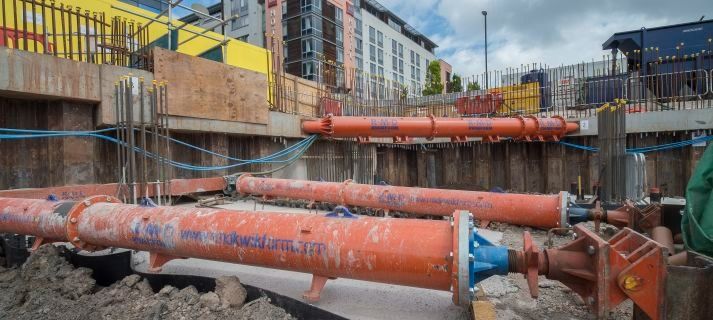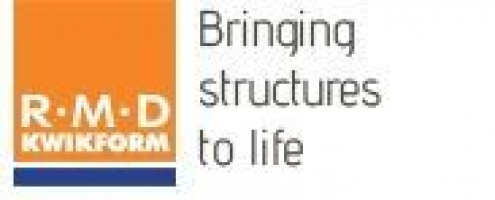-
Philippines
Copyright © 2025 Powered by BCI Media Group Pty Ltd
Confirm Submission
Are you sure want to adding all Products to your Library?
Contact Detail
13 Sep 2020 by Megashor

Hired help or bought support?
Choosing whether to buy structural steel or hire proprietary props to support deep excavations is not a simple choice and a number of factors must be considered. Claire Smith reports.
Since proprietary propping solutions were first launched into the UK market by Mechplant in the 1990s, their use has grown significantly but their seeming ubiquity does not mean they are the only solution. It is difficult to say what proportion of projects use hired proprietary props and the volume that use structural steel as the choice depends more on the individual project than just market trend.
“The duration of the project is a key factor but the loadings also influence the decision,” explains RMD Kwikform commercial director John Breen. “After a duration on site of 26 weeks, generally structural steel is a more cost effective solution.
“For example, major project such as Crossrail often take much longer than 26 weeks so are more likely to choose structural steel for support of deep excavations, whereas basement schemes often take less than 26 weeks so proprietary systems are usually more efficient.
“Key considerations are time and construction programme,” he says. “Structural steel is slower to install due to the need to fabricate sections on site and weld them into place. The availability of skilled labour is also a consideration, along with the health and safety issues that come from having hot trades on site.
The price of structural steel also fluctuates with availability and exchange rates, plus the size of steel specified in the design may not be readily available so you have to size up which may not give the optimum solution and further add to costs.”
According to RKD director Adam Pellew, the point of on the benefits of each approach also varies whether you are looking at it from a contractors’ or designers’ perspective too.
“From the contractor’s perspective, they want the cheapest option,” explains Pellew.
“If they have certainty of the construction programme then the hire rate and mobilisation costs give them a clear view. But on longer projects or those where the programme is subject to change the cost of buying steel at £2,000 per tonne gives them more flexibility on time and when to remove the props.”
Breen agrees that cost is still one of the biggest deciding factors. “With structural steel, the project team have reassurance of fixed costs – once the steel is purchased there is no increase in cost,” he says. “If you are using proprietary systems and there is an issue on site that causes the work to take longer than anticipated, then costs will go up.”
Nonetheless, the flexibility with hire is still attractive as it may also allow props to be removed early to speed up excavation operations.
“From an engineering point of view, the top level props are in for the longest but the bottom ones may be in place for a matter of weeks,” adds Breen.
Pellew says that the choice of structural steel over proprietary props also calls for a different design philosophy, which is where the designers point of view comes into play.
“Structural steel is usually pre-loaded to 25% of the design service load to remove thermal effects from its performance but proprietary props are jacked to 70%,” says Pellew.
“At higher jacking loads soils models show more than 5mm of movement but actually it is less than 1mm because they effectively act like ground anchors and ground models are not good at predicting ground movement. It is easier to model movements using structural steel. Pre-stressed props and ground anchors behave well but it is the prediction that is difficult.”
Arup director Dinesh Patel believes that the influence of temperature effects on props will also become more critical as the trend towards deeper basements – placing larger loads on props – grows and place more emphasis on the jacking loads. “We painted the proprietary props used on 10 Fenchurch Avenue white to help manage the issue but maybe in the future we will see insulated props?” he says.
The sensitivity of the neighbouring buildings and details of the new building itself are also important considerations.
“The loading that a proprietary prop can manage will depend on the strength of the bolted joints between sections and hydraulic capacity of the system,” says Breen. “As a general rule structural steel can carry higher loads and offer a higher degree of stiffness, which may be vital on more sensitive structures.”
Pellew adds: “The integration of temporary works for façade retention is also an influencing factor on the propping solution as such projects use structural steel for the above ground structure, so it is easier to integrate the same system to the below ground support. The sensitivity of neighbouring sites is another major factor in the choice of structural steel where the additional stiffness creates less risk of ground movement.
“Off the shelf approaches don’t always suit unusual shaped sites either.”
Nonetheless, Breen believes that once on site, proprietary props can offer advantages when it comes to ground movements. He says that such systems offer greater ability to manage wall deviation plus they also offer load monitoring capabilities.
“You can use strain gauges with structural steel but the results are not as accurate and it is not as easy to review the results in real time,” says Breen.
Patel says he often favours hired solutions “as they are often instrumented to measure pressure and load”.
The construction programme and buildability of the scheme are other influencing factors, as well as physical space on site.
“Proprietary props can be delivered just in time and lifted straight into position and allow the muck shift operation to get underway more quickly,” says Breen.
“Hiring means that contractors do not have to have their own fleets of equipment that may not be fully utilised and the hire option gives them access to a wider range of prop sizes too.”
However, Pellew says that hiring can add other financial issues to the mix. “There is the risk of damage to hired props that needs to be factored in,” he says. “If the excavation needs large props that are closely spaced, then there is a higher risk of damage.”
Breen says that the ideal solution for many sites could be a combination of the two approaches with a structural steel frame at the top and proprietary propping at the lower levels but he says that is rarely considered. Whatever the choice though, Breen urges contractors and consultants to engage early with ground shoring suppliers to help ensure the right solution is selected to suit the scheme.





Save Company
Add All Products to My Library
Send Meeting Request to this Supplier